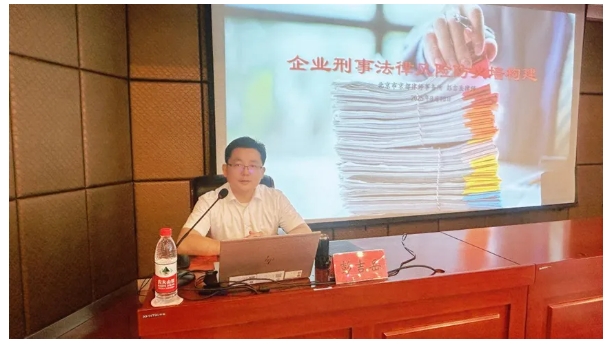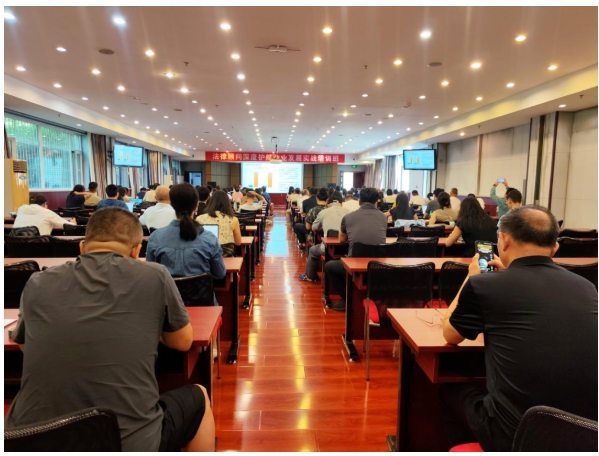On August 10, 2025, the Beijing Lawyers Association held a “Practical Training Course on Legal Advisors Providing In-depth Protection for Enterprise Development,” and Peng Jiyue, senior partner at King&Capital Law Firm in Beijing, was invited to be the keynote speaker. Attorney Peng Jiyue delivered a presentation titled “Building a Firewall Against Criminal Legal Risks for Enterprises,” sharing his practical experience and profound insights accumulated over years of case handling with fellow Beijing lawyers participating in the training. Attorney Peng Jiyue candidly stated that the content shared during this event was based on his genuine experiences accumulated over the years. Having witnessed the ups and downs in the lives of many entrepreneurs, he sincerely hopes that those who have worked hard to start their own businesses can live a peaceful life and receive the respect they deserve from society.

I. The Severe Current State of Corporate Criminal Legal Risks
At the beginning of his presentation, Peng Jiyue used a series of detailed data to reveal the severe situation of criminal legal risks currently faced by enterprises. According to the JinDu Research Institute's “Report on Criminal Offenses by Listed Companies (2022-2024),” the number of criminal cases involving A-share listed companies has been on the rise for three consecutive years: 79 companies were involved in criminal incidents in 2022, 92 in 2023, and 97 in 2024, with the proportion of companies involved in criminal cases reaching 5% of all A-share listed companies over the three-year period.
In terms of the distribution of criminal charges, in 2024, securities-related crimes accounted for 42% of criminal cases involving listed companies, fraud-related crimes accounted for 15%, and duty-related crimes accounted for 13%. In cases where companies were subjected to criminal harm, duty-related crimes accounted for a staggering 59%, with crimes such as embezzlement and misappropriation of funds occurring frequently, exposing significant vulnerabilities in companies' financial security and internal controls.
What is even more concerning is that private entrepreneurs have become a high-risk group for criminal offenses. Data from the China Entrepreneur Crime Prevention Research Center at Beijing Normal University shows that from 2017 to 2021, private entrepreneurs accounted for 87.9% of criminal offenses and 88.3% of the number of offenders, far exceeding the proportion of state-owned enterprise executives. Moreover, despite the overall decline in criminal crime rates, the rate of criminal cases involving enterprises has risen against the trend—in 2024, the number of criminal cases nationwide decreased by 25.7% year-on-year, but the number of individuals prosecuted by the procuratorate for crimes disrupting the socialist market economy increased by 13% year-on-year. Among corporate corruption crimes, the number of individuals prosecuted for internal corruption within private enterprises increased by 25% year-on-year.
"Cases such as the ‘Prince Milk Case,’ the ‘Xu Case,’ and the ‘Xia Case’ of breaching trust and harming the interests of a listed company all confirm a harsh reality: criminal cases involving private enterprises are prevalent in China. As the core of the enterprise, when entrepreneurs are involved in criminal cases, it often means the enterprise loses its leader, operations are interrupted, and credibility collapses, ultimately leading to its demise. “ Peng Jiyue's words were filled with sorrow, ”I firmly believe that criminal defense is not just about ‘closing the barn door after the horse has bolted,’ but should also serve as a ‘lifeline’ to keep the company alive."
II. Measures for Building a Criminal Legal Risk Firewall
Regarding how to build a criminal legal risk firewall for enterprises, Peng Jiyue proposed a systematic solution, emphasizing prevention at the source and comprehensive process control.
Compliance with business models is a prerequisite. Using the case of an online lottery platform suspected of operating a gambling operation as an example, he pointed out that some companies use “innovation” as a pretext to engage in illegal activities such as gambling and fraud—the platform manipulated odds and made false claims to create the illusion of high returns, ultimately being deemed to have “established a gambling operation.” “Compliance must be embedded into the business model design from the outset. Be vigilant against ‘crime disguised as technology.’ For example, the ‘consumer rebate + new customer commission’ model may form a ‘fund pool,’ potentially constituting a Ponzi scheme; blockchain ‘ecological tokens’ with ‘principal and interest repayment’ features may be suspected of illegally absorbing public deposits.”
The implementation of internal systems is the core. In the case of Lin Moumou's embezzlement, over 90 million yuan in auction proceeds were easily transferred, exposing systemic flaws such as lax loan approval processes, unclear property rights, and the absence of monitoring for large-scale fund movements. Attorney Peng Jiyue emphasized that companies must establish rigid systems: loans must undergo multi-level approval and repayment tracking, property management responsibilities must be separated to create checks and balances, and the use of large sums of funds must be approved at all levels and monitored throughout the process. “Systems cannot be mere decorations on the wall; they must become ‘high-voltage wires’ that carry electricity.”
Employee awareness and behavioral norms are critical. Employees of a live-streaming company colluded with external parties to launder money, and the company failed to detect the issue in a timely manner due to an ineffective complaint handling mechanism, ultimately paying over 100 million yuan in illicit gains. In response, he recommended that companies regularly conduct legal training, establish a comprehensive record-keeping system for complaint handling, and standardize third-party collaborations to address risk gaps from a “human” perspective.
Additionally, intellectual property protection and anti-bribery measures are key priorities. Cases such as Li Moumou being charged with patent infringement for using another's patent packaging and Zhang Moumou facing over ten years in prison for bribery demonstrate that unauthorized use of intellectual property and “quid pro quo” transactions between officials and businesses will result in severe consequences.
III. Analysis of the Causes of Corporate Criminal Legal Risks
When analyzing the causes of frequent corporate criminal risks, Peng Jiyue pointed out that the root cause lies in the interplay of external environmental factors and internal management issues.
Externally, an unfair market competition environment puts pressure on enterprises: private enterprises face discrimination in financing, tax policies have disparities, and some enterprises are forced to “cross the line” to survive; the phenomenon of public power seeking rent still exists, with excessive concentration of power and lack of supervision, leaving some enterprises in a dilemma where “without connections, it's hard to develop, but with connections, they cross the red line.” Additionally, the lag in legal frameworks and the distortion of traditional cultural norms further blur the boundaries between innovation and compliance, making it easier for companies to lose focus.
Internally, companies' own issues are even more pronounced: weak legal awareness and insufficient understanding of criminal risks, such as some companies mimicking others' “successful models” without considering the legal risks involved; Institutional frameworks are often ineffective, with flaws in processes such as fund approval and asset management, providing opportunities for embezzlement and misappropriation of funds; The pursuit of profit often overrides rationality, leading companies to take risks in financing and operations that involve illegal activities such as absorbing public deposits or bribery.
IV. Basic Principles for Building a Criminal Legal Risk Firewall for Companies
Attorney Peng Jiyue emphasized that establishing a criminal legal risk firewall for enterprises must adhere to five fundamental principles to provide clear guidance for risk prevention and control.
Prevention-oriented, combining prevention and control: It is necessary to proactively identify risk sources in key areas such as business models, cash flows, and contract design, establish compliance systems, review mechanisms, and monitoring mechanisms, and simultaneously activate rapid response procedures when criminal signals emerge to minimize risk losses.
Comprehensive Coverage: Focus on risks across all stages of a company's lifecycle—including the establishment phase (such as false capital contributions or capital withdrawal), operational phase (such as bribery or fraudulent invoicing), transformation phase (such as financial fraud or financing fraud), and liquidation phase (such as malicious debt evasion or bankruptcy fraud)—to ensure comprehensive risk prevention with no blind spots.
Key Focus: Focus on high-risk positions such as finance, procurement, and sales, as well as high-risk behaviors such as business rebates, transfers from corporate to personal accounts, and government project applications, to develop targeted preventive measures and strengthen regulatory oversight.
Clear responsibilities and collaborative action: Clarify the ultimate responsibility of the legal representative, define the scope of responsibilities for senior executives, and ensure the responsibilities of compliance officers, legal counsel, and other specialized roles are fulfilled. Establish a joint management mechanism involving legal, business, audit, and HR departments, and conduct joint risk assessments prior to major decisions.
Dynamic Adjustment and Continuous Optimization: Closely monitor revisions to the Criminal Law to promptly define business “red lines”; analyze management vulnerabilities through case reviews of employee involvement in criminal cases, and update risk prevention lists; introduce intelligent early warning systems to monitor “high-risk signals” such as large-scale fund movements through digital tools, achieving risk control upgrades.
V. Summary and Outlook
Attorney Peng Jiyue summarized the core points of constructing a criminal legal risk firewall for enterprises: business models must be lawful and compliant, internal management systems must be sound, employees' legal awareness must be strengthened, commercial activities must prevent bribery, and intellectual property risks must be prioritized. He also highlighted common lessons from cases: inadequate systems lead to actions without legal basis, and insufficient understanding of legal risks results in inappropriate handling methods.
In the future, corporate criminal risk prevention will exhibit two major trends: first, stricter regulation, with areas such as quasi-financial services, contracts, data, and cross-border operations becoming key areas of control, requiring enterprises to assume greater proactive reporting and self-responsibility obligations; second, prevention mechanisms will become more systematic and intelligent, with enterprises leveraging internal risk prevention mechanisms and technological tools to enhance risk warning and legal judgment capabilities.
Attorney Peng Jiyue specifically proposed the concept of “three layers of firewalls”: business departments conduct self-inspections and self-control, with frontline staff constantly reviewing the legality of their actions; functional departments review and approve, with legal and financial departments proactively warning of compliance risks; and management supervises and holds accountable, establishing a responsibility tracing mechanism to ensure that risk prevention becomes the shared responsibility of the entire company.
In his concluding remarks, Peng Jiyue quoted President Xi Jinping's statement: “Under the rule of law, no one can harbor illusions of impunity or expect leniency outside the law; there are no ‘pardon certificates’ or ‘privileged titles.’” He emphasized that companies must respect the law and strengthen compliance defenses to ensure steady and sustainable development. “I hope every entrepreneur will uphold the bottom line, create wealth, earn societal respect, and live a life of peace and security.”





